Seeing the structure beneath the surface
In every landscape, beneath the chaotic appearance of nature, an invisible structure is hidden.
Lines of force, directions, balances, imperfect symmetries.
In my photographic process, composition is never decorative: it is an act of reading, a search for order in the apparent disorder of reality.

SURF AND ROCKS, BALLYCOTTON LIGHTHOUSE, COUNTY CORK
When working in black and white, this structure becomes everything.
Without color to guide the eye, what remains are the shapes, the volumes, the contrasts.
⸻
Composing with the landscape, not on top of it
My photography starts from a simple principle: the landscape must reveal itself, not be forced.
For this reason I always try to compose by listening.
I move slowly, sometimes for hours, waiting for the position of my body, eye and frame to coincide with something that feels “right.”
I look for:
• Lines that cross the frame (paths, ridges, bands of light).
• Contrasts that define volumes (rocks, waves, thick clouds).
• Repetitions that create rhythm (tall grass, stones, sea breaks).
• Negative spaces that open up the image’s breath.

CAPEL ISLAND, WINTER SUNSET, KNOCKADOON, COUNTY CORK
⸻
Black and white as a compositional tool
Black and white amplifies the form.
It strips the image of every distraction and brings the natural graphics of the landscape to the fore.
A curve of the coast can become an abstract line.
A rock, with the right contrast, can look like a primitive sculpture.
“Composing in black and white means thinking in terms of light and structure, not subject. It is a form of poetic abstraction.”
In many of my images, I deliberately chose to lower the clarity in certain areas, to let the shape emerge through the shadow. In others, I emphasized the detail to transform a texture into visual rhythm.
⸻
The panoramic format as a compositional choice
One of the most distinctive elements of my project was the use of the panoramic format.
Not only for an aesthetic question, but for a real need for compositional breadth.
• The panorama allowed me to explore the relationship between distant elements in space.
• It forced me to think horizontally and vertically, considering the image not as a single frame, but as a sequence of planes to be built and harmonized.
I created these images by composing 4 or 5 sections for each shot, and for each section I took care of the alignment with the panoramic slide to avoid parallax errors.
In this way, even the technical composition became part of the language.
⸻
Composing as Meditation
There were moments when composition manifested itself as a sudden intuition.
Others, however, in which I spent long minutes balancing lines, depth and light.
In both cases, I never sought formal perfection, but the silent harmony between me and the place.

HAG’S HEAD, CLIFF OF MOHER, COUNTY CLARE
“Composition, for me, is never an aesthetic gesture. It is a way to listen better to the landscape.”